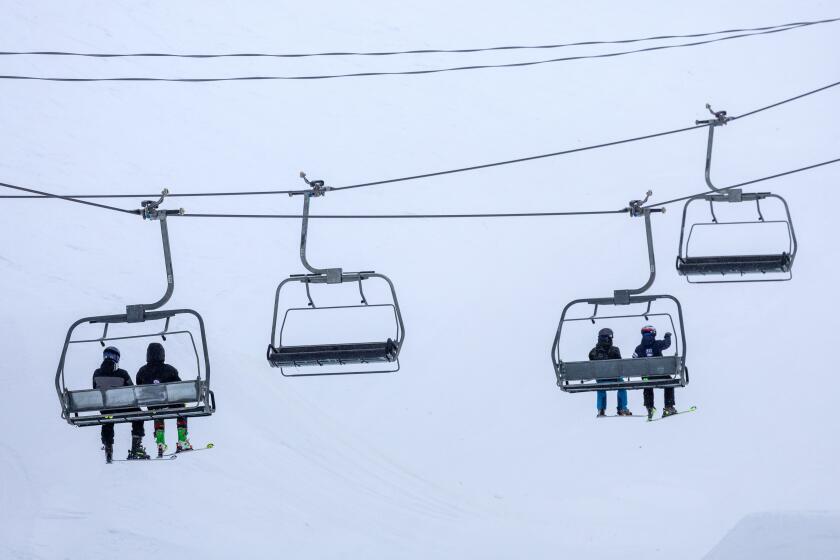Orthodox Christians are ‘raising the cross and lowering the flag’
- Share via
Philip Tamoush, who is of Syrian ancestry, and Emil Ciontea, whose parents came from Romania, wanted their families to maintain their Eastern Orthodox religious heritage while embracing an American life style.
That was becoming difficult, however, because most of this country’s Orthodox churches conduct services in the languages of Eastern Europe and the Middle East where the church is rooted. Tamoush, whose wife is of Greek ancestry, attended St. Katherine’s Greek Orthodox Church in Redondo Beach. Ciontea was a member of Holy Trinity Romanian Orthodox Church in Glassell Park. Both churches emphasized ethnic as well as religious roots.
“Our children were becoming disinterested because they couldn’t understand the language,” said Tamoush. “We knew that to meet the needs of our children we would have to attend an American Orthodox church that has services in English.”
Unfortunately, the nearest English-language American Orthodox church was St. Luke’s in Orange County, a 20- to 30-mile drive from the South Bay.
Growing weary of the long drive, the two families, joined by two other families they had met at St. Luke’s, decided to establish an English-language church in the South Bay.
This Sunday, after four years of meeting twice a month in temporary facilities in Torrance and Lomita, the Tamoushs and Cionteas will be among 40 families of various ethnic backgrounds celebrating the opening of their new, permanent location at 4102 Hickman Drive in Torrance.
“I think we can grow to 100 families in the next three years now that we have a permanent facility,” said Ciontea, chairman of the church’s governing council.
“We think there are hundreds of South Bay Orthodox who, because they lapsed or they wanted something different for their children, stopped attending church,” Tamoush said. “We think we now have something to offer them.”
The church will stress its members’ common American and Orthodox backgrounds and de-emphasize their various ethnic roots, Tamoush said. He calls it the “raising of the cross and the lowering of the flag.”
“We have Lebanese, Romanians, Egyptians, Greeks, Syrians, Serbians and Russians,” he said, noting that two-thirds of the congregation are U.S.-born. “The merging of traditions is exciting and everyone feels the unity and bond of our oneness in Orthodoxy. Subordinating ethnicity in the church to our faith presents no difficulty since we all naturally reflect the essential American nature of our lives.”
The drive toward more English-language Orthodox churches, known as the Pan-Orthodox movement, began nearly 30 years ago. Some consider it the future of Orthodoxy in North America as more third- and fourth-generation Orthodox Christians assimilate into American life styles and no longer speak their ancestral languages, church officials say.
The Eastern Orthodox hierarchy has always encouraged worship in a congregation’s native language and does not object to the growing use of English, Tamoush said.
The Eastern Orthodox Church split from the Roman Catholic Church in 1053 in a dispute over the divine authority of the Bishop of Rome--the Pope. While many of the sacraments are the same as in Roman Catholicism, married men are allowed to become Orthodox priests.
The quest to establish a Pan-Orthodox church in the South Bay began in March, 1983, when the four families started conducting services in a classroom at the Torrance YWCA and later at the school chapel of Nativity Roman Catholic Church in Torrance.
By May, 1984, the group numbered 25 families, the minimum needed to formally be recognized as a mission of St. Luke’s. In December, 1984, the Antiochian Orthodox Christian Archdiocese of North America, headquartered in New Jersey, gave the church the name St. Matthew and assigned it a parish priest, Father Paul Doyle.
The congregation leased a storefront in Lomita while it looked for a permanent church site.
The search led to a 2,000-square-foot building in north Torrance that was being vacated by the Apostolic Christian Church. The congregation raised $100,000 between last December and June for the down payment on the $275,000 building. Orthodox churches throughout Southern California helped by raising $50,000.
Tamoush said the church will have to raise about $3,000 a month to pay off the $175,000 mortgage and related expenses.
“We bought the church a little sooner than we expected, but it had to be done because you lose people in a rented place,” Tamoush said.
Father Doyle, who came to St. Matthew after seven years in Portland, Ore., said that trying to grow as a congregation out of the storefront in Lomita was difficult.
“People would call and ask for directions to our church and we would have to tell them that the facility doesn’t look like a church, that there are two apartments above it and that it is across the street from a dance studio,” he said the other day as a workman prepared the church’s interior walls for painting. “We didn’t see too many of those people.”
Doyle paused a moment, looked around at his new church, smiled and said, “Now I don’t have to say: “It doesn’t look like a church.”
More to Read
Sign up for Essential California
The most important California stories and recommendations in your inbox every morning.
You may occasionally receive promotional content from the Los Angeles Times.










